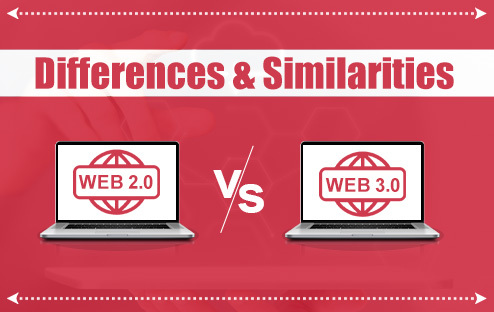
Web 2.0 vs Web 3.0- Know The Differences & Similarities
The internet has undeniably revolutionized the way we connect, consume information, and conduct business. Over the past few decades, we’ve witnessed a dramatic shift in how we interact with the web, transitioning from the static, one-way information exchange of Web 1.0 to the dynamic, user-centric environment of Web 2.0. Now, on the horizon, lies Web 3.0, promising a further evolution towards a decentralized, intelligent, and user-empowered web.
Understanding the core differences and similarities between these web iterations is crucial for navigating the ever-changing digital landscape.
Web 2.0: The Era of User Participation
Web 2.0 emerged in the early 2000s, representing a shift from static, one-way communication to dynamic, interactive platforms. At the heart of Web 2.0 were user-generated content, social media, and collaborative tools that empowered individuals to contribute, share, and connect on a global scale. Key features of Web 2.0 included:
Social Networking: Platforms like Facebook, Twitter, and LinkedIn redefined how people interacted online, enabling them to connect with friends, family, and communities in real-time.
User-Generated Content: Websites such as Wikipedia, YouTube, and blogging platforms empowered users to create and share content, democratizing the production and dissemination of information.
Collaborative Tools: Services like Google Docs, Dropbox, and GitHub revolutionized collaboration by allowing multiple users to work on documents, files, and projects simultaneously.
Personalization: Web 2.0 introduced personalized experiences through recommendation algorithms, targeted advertising, and tailored content delivery, enhancing user engagement and satisfaction.
Overall, Web 2.0 fostered a culture of participation, collaboration, and interactivity, laying the foundation for the social web as we know it today.
Web 3.0: The Era of Decentralization and Semantic Web
As we transition into the era of Web 3.0, we witness a paradigm shift driven by decentralization, interoperability, and semantic technologies. Web 3.0 represents a vision of the internet where data, services, and applications are decentralized, enabling greater autonomy, privacy, and security for users. Key characteristics of Web 3.0 include:
Decentralization: Distributed ledger technologies such as blockchain form the backbone of Web 3.0, enabling peer-to-peer transactions, smart contracts, and decentralized applications (DApps) that operate without intermediaries.
Interoperability: Web 3.0 aims to break down silos and create seamless connectivity between different platforms, protocols, and systems, fostering an ecosystem where data and services can freely interact and interoperate.
Semantic Web: Semantic technologies enhance the meaning and context of data on the internet, enabling machines to understand and process information more intelligently. This facilitates advanced search capabilities, personalized recommendations, and context-aware services.
Privacy and Security: Web 3.0 prioritizes user privacy and security through encryption, self-sovereign identity, and decentralized authentication mechanisms, empowering individuals to control their digital identities and data.
Web 3.0 represents a shift towards a more transparent, inclusive, and secure internet, where users have greater control over their online interactions and data.
Differences and Similarities
While Web 2.0 and Web 3.0 represent distinct phases in the evolution of the internet, they also share some commonalities and overlapping themes:
User Empowerment: Both Web 2.0 and Web 3.0 emphasize empowering users to create, share, and interact with content and services online, albeit through different mechanisms.
Technological Innovation: Both phases are characterized by significant technological innovations that reshape how we use and perceive the internet, whether through social media platforms in Web 2.0 or blockchain and decentralized applications in Web 3.0.
Focus on Collaboration: Collaboration remains a central theme in both Web 2.0 and Web 3.0, albeit with different emphases. Web 2.0 focuses on collaborative content creation and sharing, while Web 3.0 emphasizes decentralized collaboration and interoperability.
Impact on Society: Both Web 2.0 and Web 3.0 have profound implications for society, influencing how we communicate, collaborate, conduct business, and navigate the digital world. From social networking to decentralized finance, these paradigms shape our online experiences and interactions.
In conclusion, the transition from Web 2.0 to Web 3.0 represents a significant evolution in the internet’s capabilities, from user-generated content and social networking to decentralization and semantic technologies. While each phase brings its own set of characteristics and implications, they are interconnected in their quest to empower users, foster collaboration, and advance the capabilities of the internet. By understanding the differences and similarities between Web 2.0 and Web 3.0, we can better appreciate the ongoing evolution of the internet and its transformative potential in shaping the future of digital society.
ALSO READ: Digital marketing and Ecommerce- How are they related to each other?
 AJ 14, Salt Lake, Sector 2, Kolkata - 700091 |
AJ 14, Salt Lake, Sector 2, Kolkata - 700091 |  743 Virginia Ave NE Atlanta, GA 30306
743 Virginia Ave NE Atlanta, GA 30306


